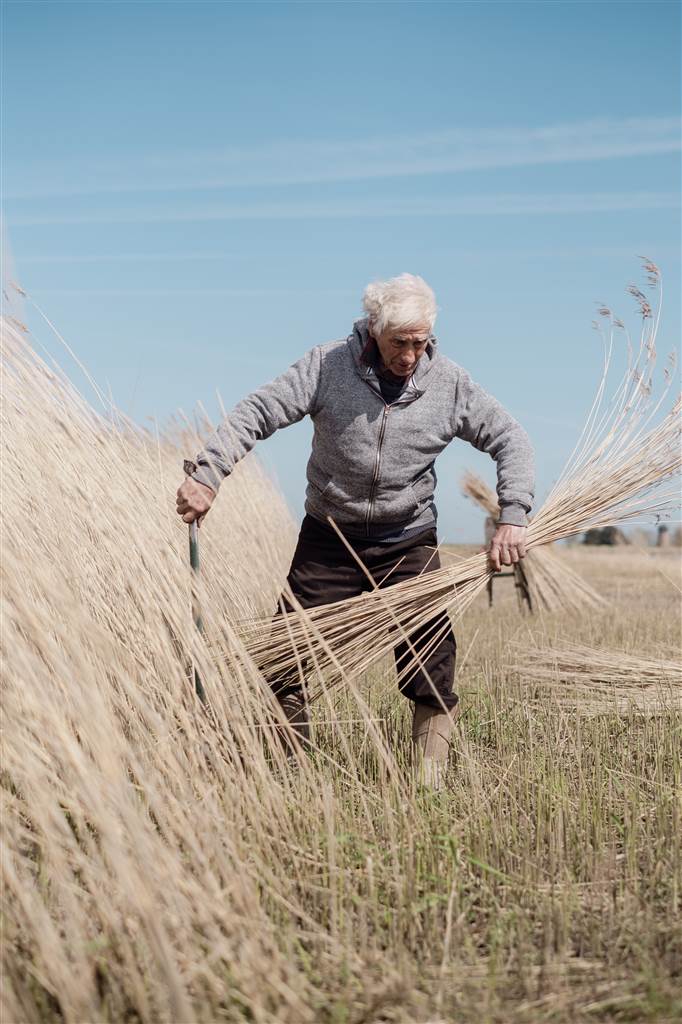

If you spend your life on the marshes, you notice the weather, the daily and seasonal changes, as well as the extremes.
“Seen a lot of changes in my time,” says Wally, “including the 1953 floods, 1963 winter and the gales of 1987.”

Wally was born in 1947. He began reed cutting with his father in the winter of 1963, near Rockland, and remembers the River Yare being frozen – a harsh introduction to working life.
His father would check the wind direction to know which way to cut the reed, and Wally learnt the knack of walking and cutting with the scythe at the same time, cutting swathes of about a yard of reed with each swish of the scythe. Even when he had other local jobs, for reed cutting is by its nature a seasonal occupation, taking place in the winter, he’d cut at weekends with his father.
Now his own three sons work with him when they can. He still cuts regularly, though it’s become a hobby rather than a living. Over his time he’s seen the changes from cutting by hand with a scythe, a method unchanged itself for hundreds of years, through to machine cutting with a form of mower. When he started, everyone cut by hand, now very few do on a regular basis, apart from Wally. When he was younger, he’d cut 50-60 bundles on a good day. Reed is sold by the bundle and it must take three hand spans to get round a bundle, generally taken as 24” now; the strings used to tie a bundle are 28-30” long.
It’s hard work in tough conditions however you do it, but Wally has adapted over the years and now uses a small hand scythe and a small wooden frame to rest the bundle of reed against while cleaning and dressing it. Yes, raking or combing out the unwanted broken or old pieces of reed or any bits of other plants and loosely tying the bundle is known as ‘cleaning and dressing’. He uses the traditional board to tap the base of the bundle on to get it tight and into shape and then tied tightly. The good thing about hand cutting is that there are no odd loose or short pieces, it’s better cleaned and therefore of a better, more uniform quality; thatchers like it for the high quality. Norfolk reed should last over 50 years on a thatched roof.
In the Broads, there are large areas of commercially cut reedbeds in the valleys of the rivers Ant and Thurne, at places such as How Hill (where the Broads Authority harvests from the nature reserve), Hickling and Horsey, and at Haddiscoe Island, where Wally mainly cuts now. Cutters need to have permission from the landowner, often a farmer, to go and cut, and may also have to pay a fee. Management for nature conservation, maintaining the water levels and keeping the reedbeds cut and clear of scrub, makes good commercial sense too, producing good quality reed for thatching. Growing and cutting reed was the original form of paludiculture or wet farming in the Broads – see to find out more about its other recent developments. Marshes and reedbeds are also a natural flood defence.
Wally feels there’s no better place than Haddiscoe Island for wildlife and taking in the big views of the Broads. The Island is an intriguing place, surrounded by the rivers Yare and Waveney and the New Cut (a canal new in 1833). Among birds, marsh harriers and kingfishers are two of his frequently seen favourites. Sometimes he’ll see a marsh harrier chasing a hare around. There are a lot of deer in the reedbeds too, and sometimes the deer and hares will swim across a dyke (or small waterway) to safety. There are wonderful views the full length of The Island, towards Breydon Water and Burgh Castle, and you can pick out Reedham Church and of course the remains of many mills. There are very few houses though.
“After spending seven decades on our broads and rivers I feel very privileged to have done this.”
Toad Hole Cottage, How Hill
Museum of the Broads, Stalham
Haddiscoe Island is a remote place to visit, though it’s not far from Haddiscoe Station and the village of St Olaves. It’s possible to follow a perimeter path around The Island, but it’s about 12 miles over rough ground, liable to flooding. If you do intend to walk there, please plan ahead and take care.
In St Olaves you can also visit the remains of a small medieval priory.
broads-authority.gov.uk/about-the-broads/heritage-and-culture